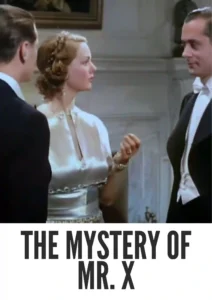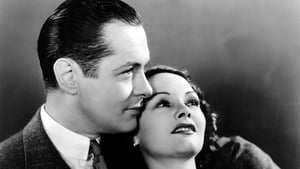Contact: info@alwanfilm.com
Video Sources 0 Views

Synopsis
Review: The Mystery of Mr. X 1934 Colorized – A Classic Thriller Revisited

Introduction
In the annals of early 20th-century cinema, “The Mystery of Mr. X” stands out as a quintessential example of the thriller genre, blending suspense, intrigue, and a touch of romance. Directed by Edgar Selwyn and starring the suave Robert Montgomery, this 1934 film has recently been reintroduced to audiences through its restored colorized version. In this article, we delve into the significance of this early colorization, its impact on the viewing experience, and the timeless appeal of “The Mystery of Mr. X.”
Check The Full Colorized Movies List
Check Our Colorized Movies Trailer Channel
Understanding The Mystery of Mr. X 1934 Colorized: Director, Cast, and Genre
“The Mystery of Mr. X” is a film noir thriller directed by Edgar Selwyn, a notable figure in early Hollywood cinema. The film stars Robert Montgomery as the charming and enigmatic jewel thief, Michael Lanyard, also known as Mr. X. Montgomery’s performance is complemented by the talents of Elizabeth Allan as his love interest, and Lewis Stone as the determined Inspector Connor.
Set in the glamorous yet perilous world of high society and crime, the film exemplifies the classic thriller genre. It combines elements of mystery, suspense, and romance, creating a gripping narrative that keeps audiences on the edge of their seats.
Exploring the World of The Mystery of Mr. X 1934 Colorized: Plot and Characters
“The Mystery of Mr. X” revolves around Michael Lanyard, a debonair jewel thief who finds himself entangled in a series of murders committed by a mysterious figure known as “Mr. X.” As Lanyard navigates the treacherous waters of London’s high society, he must outwit both the police and the real killer to clear his name and win the heart of his love interest, played by Elizabeth Allan.
The film’s plot is a masterclass in suspense, with twists and turns that keep viewers guessing until the very end. Lanyard’s cat-and-mouse game with Inspector Connor, played by Lewis Stone, adds an extra layer of tension, making the film a riveting experience from start to finish.
The Art of Film Colorization
Film colorization, the process of adding color to black and white footage, has long been a topic of debate among film enthusiasts and historians. While some argue that it breathes new life into classic films, others contend that it can compromise the director’s original vision and the film’s historical authenticity.
Colorization involves a meticulous process where each frame is analyzed and color is digitally applied, often requiring extensive research to ensure accuracy. When done well, it can enhance the viewing experience by highlighting details that might otherwise go unnoticed. However, it also raises questions about preserving the integrity of the original work.
Early Colored Films: A Brief History
The advent of color in cinema marked a significant milestone in the industry’s evolution. Early experiments with color began in the silent film era, with techniques such as hand-painting and tinting. The development of Technicolor in the 1930s revolutionized the industry, allowing for more vibrant and realistic color palettes.
Color films initially were a novelty but soon became a standard, transforming the visual storytelling landscape. However, the transition was gradual, and many films from the 1930s, including “The Mystery of Mr. X,” were originally shot in black and white.
The Mystery of Mr. X 1934 and Its Early Colored Version
The decision to release “The Mystery of Mr. X” in a colorized format offers contemporary audiences a new way to experience this classic thriller. While the original black and white version has its own charm, the colorized version brings out different aspects of the film, from the opulence of high society settings to the subtle nuances of character interactions.
Colorization can highlight details such as costume design, set decoration, and lighting, providing a richer visual experience. For “The Mystery of Mr. X,” colorization adds a layer of modernity while preserving the essence of the original film, making it accessible to new generations of viewers.
The Debate Over Film Colorization
As with any artistic reinterpretation, the colorization of classic films generates both praise and criticism. Proponents argue that colorization can make older films more appealing to modern audiences, who are accustomed to color. They also suggest that it can reveal new dimensions of the film, enhancing appreciation for its artistic and technical achievements.
Critics, however, often view colorization as a form of historical revisionism that undermines the filmmaker’s original intent. They argue that the aesthetic of black and white cinematography is integral to the film’s identity and that altering it can distort the director’s vision and the period’s cultural context.
Examining The Mystery of Mr. X 1934 as an Early Colored Film
Viewing “The Mystery of Mr. X” in its colorized version provides a unique perspective on this classic film. The added color enhances the visual storytelling, making the opulent settings and period costumes more vivid. It also brings out details in the actors’ performances, highlighting subtle expressions and gestures that may be less noticeable in black and white.
However, the colorized version also invites comparisons with the original, prompting viewers to consider what might be gained or lost in the transition. For some, the colorized version may offer a fresh and engaging way to experience the film, while others may prefer the stark elegance of the original black and white cinematography.
Influence and Legacy: The Mystery of Mr. X 1934’s Impact on Cinema
“The Mystery of Mr. X” has left a lasting legacy in the thriller genre, influencing subsequent films with its blend of suspense, romance, and complex character dynamics. The film’s innovative narrative structure and compelling performances set a standard for future thrillers, making it a touchstone for filmmakers and audiences alike.
The character of Michael Lanyard, with his suave demeanor and moral ambiguity, has become a template for the sophisticated anti-hero, seen in many subsequent films. The film’s intricate plot and clever use of suspense techniques have also inspired numerous thrillers, both in Hollywood and beyond.
Director’s Cinematic Legacy: Beyond The Mystery of Mr. X 1934 Colorized
Edgar Selwyn’s contribution to cinema extends beyond “The Mystery of Mr. X.” As a director, playwright, and producer, Selwyn played a pivotal role in the development of early Hollywood. His work spans various genres, showcasing his versatility and innovative approach to storytelling.
Selwyn’s legacy is marked by his ability to craft compelling narratives that resonate with audiences. His films often explore themes of identity, morality, and human nature, reflecting his keen insight into the complexities of the human experience. “The Mystery of Mr. X” is a prime example of Selwyn’s talent for blending suspense and drama to create a captivating cinematic experience.
Themes Explored in The Mystery of Mr. X 1934 Colorized
“The Mystery of Mr. X” delves into themes of deception, morality, and the duality of human nature. The film’s protagonist, Michael Lanyard, embodies the tension between right and wrong, navigating a world where appearances can be deceiving and trust is a rare commodity.
The theme of deception is central to the film’s narrative, with characters constantly trying to outwit each other. This theme is reinforced by the film’s visual style, which uses shadow and light to create an atmosphere of mystery and suspense. The moral ambiguity of Lanyard’s character adds depth to the story, challenging viewers to consider the complexities of human nature.
Reception and Controversy Surrounding The Mystery of Mr. X 1934 Colorized
Upon its original release, “The Mystery of Mr. X” received positive reviews for its engaging plot, strong performances, and atmospheric cinematography. Critics praised Robert Montgomery’s charismatic portrayal of Michael Lanyard and the film’s clever use of suspense and intrigue.
The recent release of the colorized version has sparked renewed interest and debate. While some critics appreciate the enhanced visual experience, others argue that the colorization detracts from the film’s original charm. This ongoing discussion highlights the broader debate about the role of colorization in preserving and reinterpreting classic films.
Where to Watch The Mystery of Mr. X 1934 Colorized Online
For those eager to experience the timeless allure of “The Mystery of Mr. X,” the film is available on several streaming platforms. Both the original black and white version and the new colorized rendition can be found, allowing viewers to choose their preferred format.
Streaming services such as Amazon Prime, Hulu, and Criterion Channel offer access to this classic film, ensuring that it remains accessible to modern audiences. Whether revisiting a beloved favorite or discovering it for the first time, “The Mystery of Mr. X” continues to captivate with its blend of suspense, romance, and intrigue.
FAQs About The Mystery of Mr. X 1934 Colorized
Q: What is the plot of “The Mystery of Mr. X”?
A: The film follows Michael Lanyard, a charming jewel thief who becomes entangled in a series of murders committed by a mysterious figure known as “Mr. X.” As Lanyard navigates the dangers of London’s high society, he must outsmart the police and the real killer to clear his name and win the affection of his love interest.
Q: Who stars in “The Mystery of Mr. X”?
A: The film stars Robert Montgomery as Michael Lanyard, Elizabeth Allan as his love interest, and Lewis Stone as Inspector Connor. The cast delivers strong performances, contributing to the film’s enduring appeal.
Q: What are the main themes of the film?
A: “The Mystery of Mr. X” explores themes of deception, morality, and the duality of human nature. The film’s narrative and visual style emphasize the tension between appearances and reality, challenging viewers to consider the complexities of trust and integrity.
Conclusion
In conclusion, “The Mystery of Mr. X” remains a standout example of early 20th-century cinema, its legacy enduring through the decades. The colorized version offers a fresh perspective on this classic thriller, inviting new audiences to experience its charm and intrigue. Whether in its original black and white format or the newly colorized rendition, the film’s compelling narrative, strong performances, and atmospheric cinematography continue to captivate viewers. As we revisit this timeless masterpiece, we are reminded of the enduring power of cinema to enthrall, entertain, and inspire.










